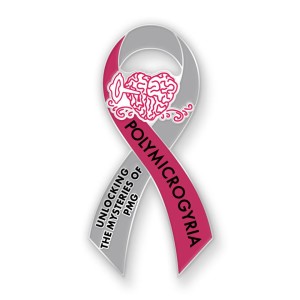Monster Swag
 It was a simple enough thing. Polymicrogyria, known around here by Schuyler as the little monster in her head, finally had an awareness ribbon, like every other affliction and cause seems to have had for years. The pink PMG ribbon is differentiated from others by the text (“Polymicrogyria” and “Unlocking the mysteries of PMG”) and by a little graphic of a vaguely heart-shaped brain with a key sticking out of it. Which is a little odd, but whatever. We refer to it as a monster; I can only imagine what it would look like if we designed it.
It was a simple enough thing. Polymicrogyria, known around here by Schuyler as the little monster in her head, finally had an awareness ribbon, like every other affliction and cause seems to have had for years. The pink PMG ribbon is differentiated from others by the text (“Polymicrogyria” and “Unlocking the mysteries of PMG”) and by a little graphic of a vaguely heart-shaped brain with a key sticking out of it. Which is a little odd, but whatever. We refer to it as a monster; I can only imagine what it would look like if we designed it.
It’s no big deal, certainly not any different from the other awareness ribbons out there. And I’m not usually a “wear this thing for the cause” kind of guy. But this? I’ve worn this thing every day since it arrived in the mail. I don’t intend to stop, either.
(I imagine Schuyler would love it if people out in the world joined us in wearing them, as would I. If you get one, send us a photo of you wearing it and we’ll post it.)
Parents of kids with rare or invisible disabilities have a slightly different road to travel than our peers in the disability community. It’s not any better or worse. I guess it just involves more explanation. Honestly, the only doctor Schuyler had ever seen who had even heard of PMG, aside from the PMG experts themselves, was her current neurologist. Not even Schuyler’s original neurologist knew what it was initially, and she was at Yale.
It can be a little frustrating, having to explain polymicrogyria. Other disorders with a great many patients receive a great deal of public awareness, as well they should, but it can feel like the oxygen in the room is very limited as a result. People ask a lot of questions based on their observations of Schuyler. Is she deaf? Does she have autism? Sometimes I go into the whole thing; other times, I just say she has a rare brain malformation and leave it at that. Sometimes I feel like being a teacher. Sometimes I’m just tired.
When I talk to other parents of kids with rare disorders, I get the sense that they feel a particularly acute isolation. Our kids are all so different, even from one another. Their stories are all so unique, their particular manifestations of symptoms so daunting.
With polymicrogyria, there are commonalities, but even those are only vaguely related. Some kids have relatively easily managed seizures, like Schuyler. Other kids die from them; I hear about them a few times a year. And sometimes kids have little or no seizure activity, until that one day they have their first and it takes them.
Those terrible case are rare, but then, so is polymicrogyria; rarity is not even a little comforting. That awful possibility hangs over this family like the Sword of Damocles. I try not to look up at it too often, but I never completely allow myself to become complacent, either. Schuyler doesn’t worry about it, and she doesn’t need to. I’ll do that for her.
Given the amount of structural malformation it contains, Schuyler’s brain is performing at a pretty high level. That is basically a miracle. If I were a religious person, I could put my faith in that miracle, believe in it in its constancy. But I see a universe that is, at best, ambivalent about us. I love that Schuyler’s brain has found a way to be so extraordinary, but I don’t trust it to keep up the good work, not one damned bit.
Schuyler and I gave a presentation at my university last week, and a large number of my fellow staff showed up, which was incredibly nice. We were both very moved. One thing I was secretly happy about was the fact that I got to tell these people with whom I work all about Schuyler and the rough but beautiful life that she lives. That’s a hard conversation to have in the break room while I’m heating up a microwave burrito. Now they know, in more detail. Now they get what my real fears and my real triumphs are. Now they get a more complete portrait of Schuyler and what her presence simply being in the world truly represents.
I guess that’s what awareness looks like. As an author, I like to think that in the tiny world of polymicrogyria, I’ve done more than my fair share of promoting PMG awareness. But I don’t know. Walking through the world with Schuyler sometimes feels like we’re carrying a secret. As she does more and more public advocacy work, Schuyler seems ever so slightly less interested in “passing” for neurotypical. It’s a slow process, and she is a teenager, so difference is not yet a thing to be celebrated. But she just might be starting to take ownership of her condition. Her monster is getting its due.
Now we have a ribbon, and we’re both wearing it out in public, as if challenging the world to notice, and maybe even to question. I asked Schuyler what she would tell anyone who asked about it, and she said, “I’m going to tell them all about my little monster.”
That seems simple enough. In reality, I can’t overstate how big and important a step that is for Schuyler. She’s slowly getting to a place where she just might be ready to talk about it. I hope the world is listening.
Note: To support the site we make money on some products, product categories and services that we talk about on this website through affiliate relationships with the merchants in question. We get a small commission on sales of those products.That in no way affects our opinions of those products and services.



Thanks for this. My wife and I lost our first child at birth to a variety of malevolent brain malformations, polymicrogyria among them. It was only because I’ve been a reader of yours that I had even heard of it, and it remains a difficult thing to explain to others.